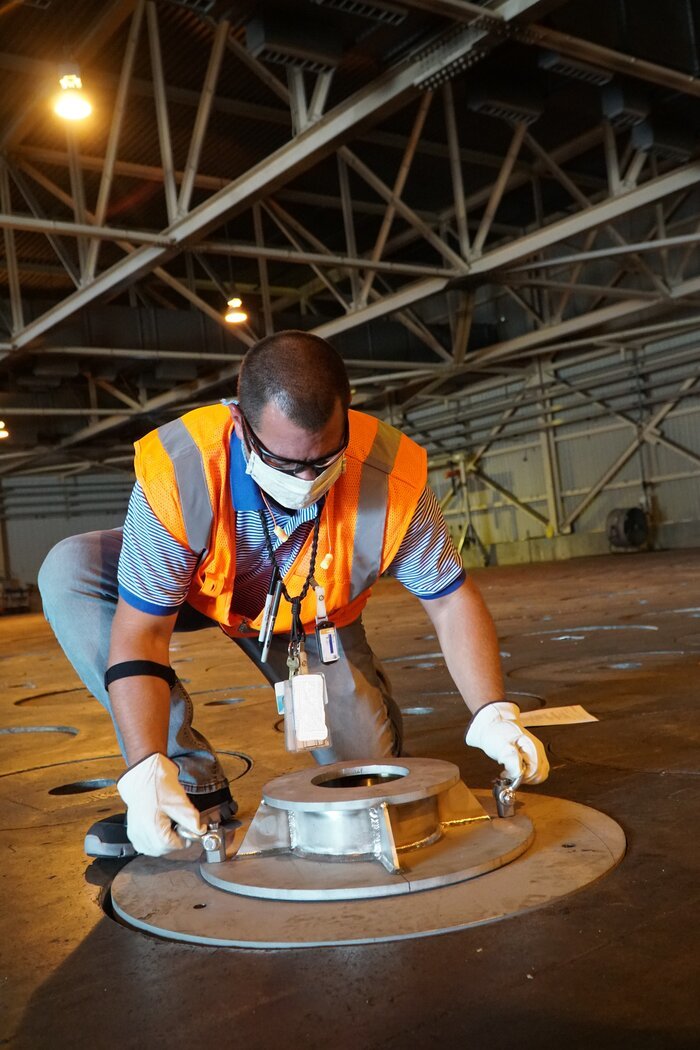 Defense Waste Processing Facility operator Stephen Potter assembles a double-stack plug grapple adapter before a feasibility demonstration.
AIKEN, S.C. – EM and its liquid waste contractor at the Savannah River Site (SRS) are advancing a project to double-stack canisters containing high-level radioactive sludge waste.
Savannah River Remediation (SRR) employees successfully demonstrated a newly designed adapter that will be used on the proposed plugs for double-stacking canisters in the Glass Waste Storage Building (GWSB) 2.
The canisters hold waste transferred from the SRS waste tanks and vitrified at the Defense Waste Processing Facility (DWPF). The filled stainless-steel canisters are safely stored in slots within a concrete and steel-reinforced underground vault inside the storage buildings adjacent to DWPF.
The canister double-stack project has been ongoing in the first storage building onsite, GWSB 1. Just over 1,000 canisters have been double stacked in GWSB 1 to date. The project will double the first building’s capacity from 2,262 to 4,524 positions.
Modifying the slots to store two canisters, one on top of the other, saves space and defers building an additional storage area, which could cost more than $100 million.
The demonstration of the grapple adapter is part of a feasibility study to determine if canisters can be double stacked in the second interim storage building, GWSB 2. The adapter is needed for the proposed GWSB 2 cast iron shield plugs due to the reduced height between the top of the shield plug and the upper canister in a GWSB 2 double-stack arrangement. The space normally occupied by the grapple cavity in the plug, below floor level, is needed for shielding; therefore, the grapple adapter was designed to be attached temporarily above the floor level of the shield plug before the plug is to be moved by the shielded canister transporter.
 A drawing of the newly designed Glass Waste Storage Building 2 double-stack plug grapple adapter.
The one-of-a-kind transporter moves and double-stacks the canisters, and maneuvers the shield plugs. Using the transporter, operators successfully completed two cycles of simulated shield plug movement using the grapple adapter, proving it viable for use.
Jim Folk, DOE-Savannah River assistant manager for waste disposition, said the adapter demonstration is key to making progress in the canister double-stacking project.
“Optimizing canister storage space at the Savannah River Site is necessary to keep the liquid waste mission moving forward,” Folk said. “Processing will be accelerated with the Salt Waste Processing Facility coming online this year, so it’s important now more than ever to ensure we are adequately prepared for on-site interim storage solutions.”
SRR President and Project Manager Phil Breidenbach said advancing double-stacking capabilities inside GWSB 2 will improve the interim storage efficiency.
“I am proud of the DWPF teams who pulled their efforts together to prove the success of the new grapple adapter,” Breidenbach said.
The feasibility study for double-stacking canisters in GWSB 2 has also included safety basis, radiological, fire protection, structural, environment, and other technical evaluations. The next step will be to conduct a demonstration of double-stacking two canisters in GWSB 2, which is anticipated for summer 2021.
Additional storage areas will not have to be built if the canisters in GWSB 2 are double stacked. The canisters will be safely stored in the GWSBs until a federal repository for high-level waste is established.
-Contributor: Colleen Hart
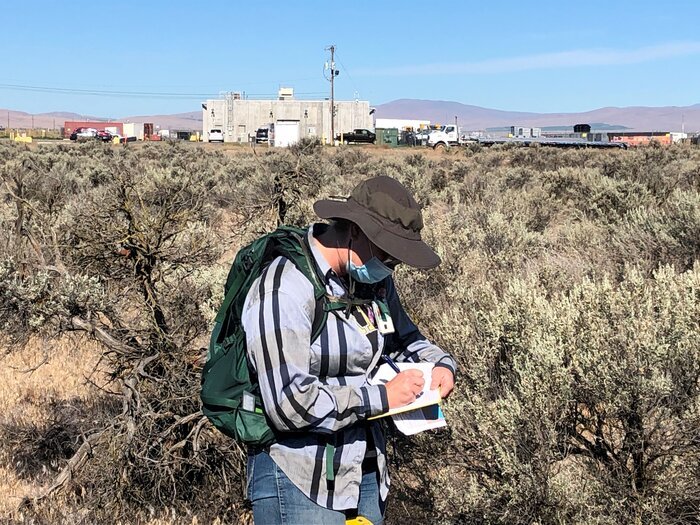 Archaeologist Lindsay Kiel with EM Richland Operations Office contractor Mission Support Alliance takes field notes during an archaeological survey on Hanford’s Central Plateau.
RICHLAND, Wash. – The Hanford Site’s distinct history and ecosystem are positioned to stand the test of time thanks to the preservation and conservation efforts of the EM Richland Operations Office (RL) site stewardship division and contractor Mission Support Alliance (MSA).
Beneath the vast shrub-steppe that encompasses the 580-square-mile site, one can find remnants of old farmsteads and hunting grounds, along with homes of black-tailed jackrabbits and sagebrush sparrows. The site’s cultural and ecological teams work to ensure site cleanup work and wildfires do not damage or threaten to remove natural resources and historical archeological data.
“Mitigating impacts to cultural and ecological resources of the site is a critical part of cleanup efforts,” said Karen Lutz, director of RL’s site stewardship division. “This work is important to ensure future generations are able to gain insight into the site’s rich history and enjoy the native plants and animals of our area.”
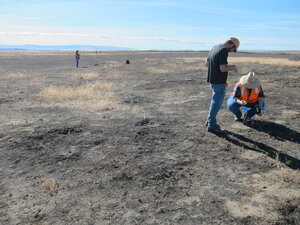 |
|
Archaeologists Keith Mendez, at left, and Mary Petrich-Guy with EM Richland Operations Office contractor Mission Support Alliance’s cultural and historic resources program document an archaeological site on the Hanford Reach national monument, with an additional survey crew in the background. This photo was taken before the COVID-19 pandemic. |
Emily Norris, an environmental scientist with EM Richland Operations Office contractor Mission Support Alliance’s ecological monitoring and compliance program, surveys wildlife in some of Hanford’s mature sagebrush habitat that make up the site’s distinct ecosystem. This photo was taken before the COVID-19 pandemic. |
|
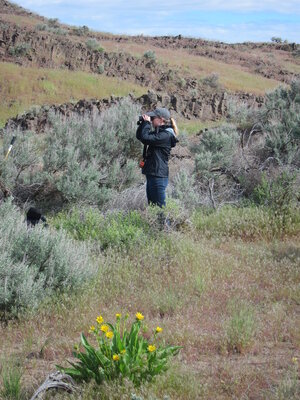 |
In addition to revegetation efforts and archaeological surveys of cleanup areas, site stewardship in remote areas affected by wildfires is also important. These areas are home to some of the most mature natural resources and provide surprising insight into prehistoric life on the site.
“We have found that the first Native Americans on this landscape could survive in an area we would not expect, using available natural resources,” said Keith Mendez, archaeologist with MSA’s cultural and historic resources program.
Maintaining compliance with federal and state regulations during cleanup is essential to efforts to assure cleanup work has minimal impact to Hanford’s unique ecosystem and historical artifacts.
–Contributors: Keith Mendez, Emily Norris, Melissa Ver Steeg
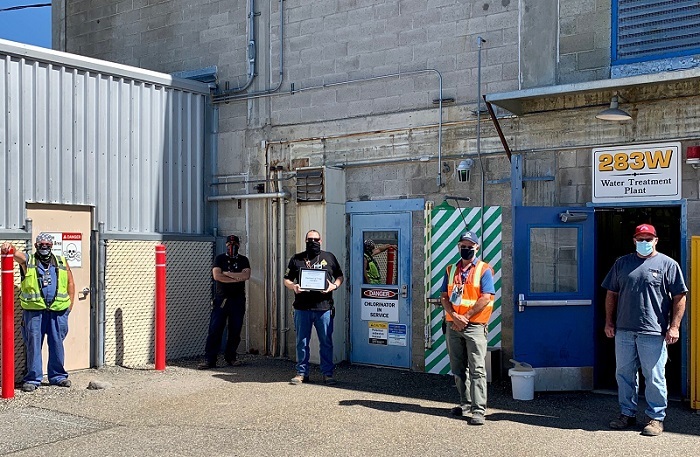 Employees for the Hanford Site’s 283 West Water Treatment Plant — from left, Vinni Dragoo, Richard Herrera, Ed Lerma, Burke Neuman, and Bob Ward — display the Silver Certificate of Achievement presented by the Washington State Department of Health. The award recognized the superb quality of drinking water at Hanford and the team’s high performance in removing even the smallest particles from water during treatment.
RICHLAND, Wash. – The Washington State Department of Health presented its distinguished Silver Certificate of Achievement to water treatment plant staff at the Hanford Site for five consecutive years of high performance on removing particles from water to help protect workers at the site.
“Workforce safety is critical to the success of any cleanup site,” said Jeff Frey, EM Richland Operations Office (RL) assistant manager for mission support. “At Hanford, we take pride in providing the highest quality drinking water possible.”
Hanford’s water treatment plant was one of only eight in the state recognized with the Silver Certificate of Achievement.
“Receiving this award during these challenging times and being recognized as one of the few receiving this award in Washington says a lot about our team,” said Bob Wilkinson, president of RL contractor Mission Support Alliance (MSA). “This award validates their hard work, dedication, and emphasis on procedural compliance.”
MSA, which operates Hanford’s water treatment plant, received the award as part of the state Office of Drinking Water Treatment Optimization Program. The voluntary program compares public water systems and presents awards based on relative performance.
To receive the silver certificate, water plant operators submitted 60 consecutive monthly reports showing their expertise on removing particles, or turbidity, from the water and meeting or exceeding other stringent regulatory criteria.
Turbidity is the cloudiness or haziness of a fluid caused by large numbers of particles generally invisible to the naked eye, similar to smoke in air. The measurement of turbidity is a key test of water quality. Contaminants like viruses or bacteria can become attached to the particles, and the higher the turbidity level, the higher the risk that people may develop gastrointestinal diseases.
“Achieving consistently high drinking water quality like this is the mark of a highly dedicated and skilled water department staff,” the Office of Drinking Water said in an email to MSA.
-Contributor: Robin Wojtanik
|